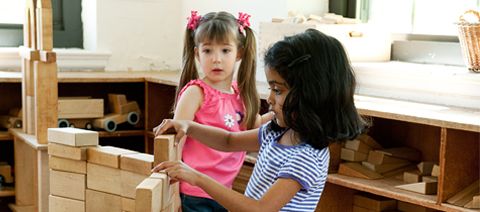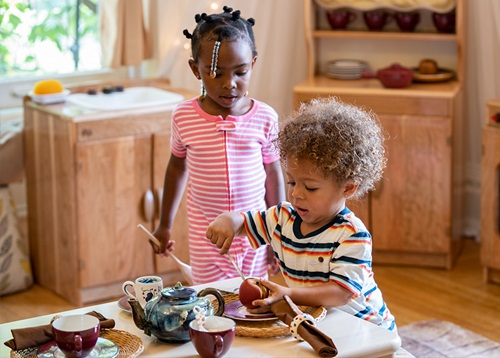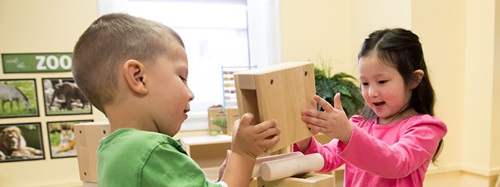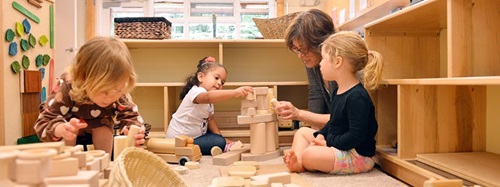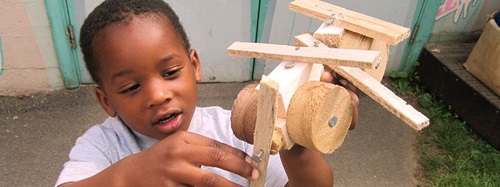Why Play with Blocks?
| December 2013History and Research of Block Play
Children have been playing with pieces of wood since the beginning of time, but of course it was Frederick Froebel who designed geometric shapes made of wood for children to manipulate, and Caroline Pratt who created the block shapes known today as unit blocks. While many countries across the world, and states such as Idaho, are making blocks an integral part of early elementary and preschool classrooms, other programs focused on test scores are removing them to provide more time for drill and specific instruction. Research has consistently shown that block play supports the development of mathematical thinking, social skills, abstract thinking, creativity, and most recently literacy (Hanline, Milton, Phelps 2009).
Sorting and Storing as Elements of Learning
Unit blocks made of dense hard wood should be accessible in a variety of different geometric shapes in all early elementary and preschool classrooms. Unit blocks should be a natural wood color, and ample shelving should be arranged to allow children to classify and organize the blocks during clean-up. The process of classifying and arranging the blocks on the shelving is an important activity and should be considered a learning experience. Young children can be taught to match the block pieces to pictures or remaining pieces on the shelving. We call this “reading the blocks”, and children as young as eighteen months of age can match and return the blocks to their proper place. The arrangement of the blocks on the shelving should be planned using the concept of seriation as a guide. The longest unit blocks (quadruples) should start on the left and each descending size should be placed along the same level of shelving. When the arrangement of the blocks on the shelving takes seriation into consideration, another learning experience is provided.
Scaffolding the Learning Possibilities
The number of blocks available, (100 per preschool child minimum, CCCRT, 2002) and the space provided for construction (a minimum of 25 square feet per child, Phelps, 2012) will control the quality of the building experience. When enough blocks, space, and teacher support (scaffolding) are provided, building with blocks can be one of the most enriching experiences an elementary or preschool classroom can provide. The Beyond Centers and Circle Time curriculum suggests that teachers employ four scaffolding components:
1) Scaffolding the Environment—Make sure there are enough blocks and enough space to support the constructions of the children. Adult picture books and children’s books about construction should be available. Pictures of bridges, buildings, etc. from around the world should enhance the children’s exploration, as should props that support children’s dramatic play with their structure.
2) Scaffolding the Pre-Play Experience—Use a book or pictures to introduce new construction ideas, review the block rules, and help the children move into their building experience as an orderly transition from the small circle to the play.
3) Scaffolding the Individual Child’s Construction —The teacher should move from child to child, offering support and advice when needed, while expanding both receptive and expressive language.
4) Scaffolding the Post-Play Experience —Share each child’s construction with the group and allow children to express their thoughts about their construction. Pictures using digital cameras allow teachers to document the constructions for the children’s portfolios and to display for the class and parents.
The Value of a Playful Early School Experience
With the disappearance of play from the classroom, opportunities to develop more than specific facts is diminishing from children’s lives. This push for explicit knowledge is being driven by the testing focus of many states and the standards required by the “No Child Left Behind” Act. The misinterpretations of these standards and the anxiety caused by other requirements have made many teachers forget the joys of a playful early school experience. Teachers must be helped to understand the standards that are in place in their location and to use those standards to enhance children’s play opportunities (Drew, Johnson, Meckley, Nell, 2008). There are no standards written that cannot be supported through play, and especially scaffolded play with blocks.
Despite an abundance of support for allowing children to play with blocks, some teachers do not like block play and often suggest that blocks take up too much classroom space, are dangerous, and definitely too noisy. The majority of teachers in early childhood classrooms are women and few women played regularly with blocks when they were young.
This makes blocks an uncomfortable play material for some. Wise teachers understand the importance of block play, and strive to understand its use and value in their classrooms. They also make every effort to understand the standards in their state and become skilled at knowing how to embed them into meaningful play experiences.
The Teacher’s Role
The teacher’s role in children’s play with blocks has become more and more important, as recent research has shown (Hanline, Milton, Phelps, 2009). Children should be allowed to explore and create at their own pace, but the teacher should be present to add language and new information to the experience. The correct names of the geometric shapes should always be used, and opportunities for children to discuss their constructions provided. The structures should not be criticized, but their design and use of shape should be discussed. Through such language exchanges, the world becomes relevant to children. That’s why books about construction, as well as pictures of structures from around the world, should be available for children to explore, discuss, and evaluate.
Blocks of all sizes are a medium that should never be excluded from a well planned and designed elementary or early childhood classroom. Wooden blocks are not only a classic play material but they offer children opportunities to develop skills in every domain of development: physical, social, emotional, and cognitive. These opportunities are often missed when adults do not scaffold and enhance block play, intentionally supporting each child’s individual development.
References:
Bultman, S. (1997). The Froebel gifts 2000: The building gifts 2-6. Grand Rapids: Uncle Goose Toys, Inc.
The Creative Center for Childhood Research and Training (CCCRT) (2002). Beyond centers and circle time: Scaffolding and assessing the play of young children. Printed in China: Kaplan Early Learning Company.
Gregory, K. M., Kim, A. S., & Whiren, A. (2003). The effect of verbal scaffolding on thecomplexity of preschool children’s block constructions. In D. E. Lytle (Ed.),Play and educational theory and practice (pp. 117-133). Westport, CT: Praeger Publishers.
Hanline, M. F., Milton, S., & Phelps, P. C. (2009). The relationship between preschool block play and reading and math abilities in early elementary school: A longitudinal study of children with and without disabilities. Early Child Development and Care.
Stannard, L., Wolfgang, C. H., Jones, I., & Phelps, P. (2001). A longitudinal study of the predictive relations among construction play and mathematical achievement. Early Child Development and Care, 167, 115-125.
All of our block research articles can be found on our web-site www.cccrt.org

